Hallux valgus is a common orthopedic pathology.It is usually treated surgically.Conservative methods - movement therapy, massage, physical therapy, drugs - play a significant role in the prevention and postoperative rehabilitation of hallux valgus.In the article, we discuss treatment methods for hallux valgus and big toe deviation.
What is hallux valgus?
This is a disease in which the big toe moves to the side and bone appears in the area of the metatarsophalangeal joint.According to ICD 10, the pathological code of hallux valgus is M20.1.
Main reasonHallux valgus is considered a diseasehereditary weakness of the connective tissue.The provoking factors are:
- wearing tight shoes;
- constant walking in heels;
- excessive loads.
Less often, hallux valgus deformity occurs due to developmental disorders, injuries or other diseases.
Hallux Valgus degrees and symptoms
There are several classifications of hallux valgus, which distinguish 3 or 4 degrees of pathology.The authors of the guidelines for orthopedists use the following systematization of the stages of hallux valgus:
| Degree | The angle of deformation, in degrees | Signs of deformation |
| 1 (weak) | Less than 20 | Painless lump.Sometimes there is discomfort after a long walk. |
| 2 (average) | 25-35 | Severe curvature, difficulty walking in shoes with heels and narrow toes.Possible pain, corns and recurring arthritis. |
| 3 (difficult) | More than 35 | Severe deformity, problems choosing shoes, difficulty standing and walking, gait changes.Frequent pain, calluses, corns and accompanying changes in the feet are typical. |

Treatment of hallux valgus deformity of the first toe
The only way to correct severe hallux valgus is surgical correction.Conservative techniques are used mainly in the initial stages of deformation.Hallux Valgus is treated by an orthopedist.
The main method of determining the degree of pathology is X-rays, which are taken in two projections with a load.In addition, the doctor may prescribe plantography, CT, MRI and other tests.
Surgery to correct Hallux valgus
In case of moderate and severe hallux valgus deformity, surgical treatment is recommended.At the patient's request, minor surgery is sometimes performed to eliminate the cosmetic defect.There are several ways to remove the knot:
- exostosis resection;
- osteotomy;
- tendon transfer according to McBride et al.
The intervention is performed using the usual method or percutaneous correction (with a small puncture).It is possible to cut out the growth with a laser.One or more incisions are made on the side or back of the leg.The cone is cut, sometimes artificial fractures of the main phalanx or the 1st metatarsal bone are created, the fragments are fixed with screws.
In the initial stages of Hallux valgusthe operation takes 30-40 minutes, with severe deformation -up to an hour and a half.
Rehabilitation after removal of Hallux valgus
Recovery from lump removal takes about 2 months.The key to a complete recovery is strict adherence to the orthopedist's recommendations.If the rules of rehabilitation are ignored, long-term complications after the operation may develop - the re-development of hallux valgus or the limitation of the movement of the joints during life.
What shoes should I wear after surgery?
From the second day, you can walk in Baruk's shoes.Before the swelling goes down, you have tomove as little as possible, most of the time the patient lies with his legs elevated.After 2 weeks, walking restrictions will be lifted.The use of Baruk boots is mandatory for 1-1.5 months after the bone has been cut.Then you can wear baggy sneakers or wide-toed boots.
He must give up his heel for six months.
Is massage possible after surgery?
The massage can be performed after the wound has completely healed.To improve blood circulation and lymphatic drainage, massage the entire lower part of the limb.The procedure begins with stroking.Then, knead the soles and feet in circular motions.Grasp the ankle joint with your hand and move towards the knee.In the final stage, punches are performed again.
Exercise therapy for legs with screws
Physiotherapy is a mandatory part of the hallux valgus rehabilitation period and begins in the third week after surgery.First, bend and stretch the finger three times, holding each position for 10 seconds.The exercises are repeated 3-4 times a day.All movements should be done carefully, avoiding discomfort.
From the second month after the removal of hallux valgus, the number of repetitions increases to 7-8, and the number of approaches increases to 6-8 per day.Discomfort is acceptable.Active movements are complemented by passive (hand) movements.After a month and a half, you need to stand on your toes 5-6 times a day, 7-8 times, and hold this position for about 10 seconds.
It is useful to walk on an inclined surface and climb stairs.

Corrective dressings
After stopping the use of Baruk shoes, corrective bandages are used.The products consist of two bandages that are connected by a hinge and fix the thumb in an abducted position.After 1-1.5 months, the bandage is replaced with silicone pads.The leg should not be compressed– this interferes with blood circulation and can cause soft tissue injuries.
How to get rid of hallux valgus without surgery
In the advanced stage of hallux valgus, it is impossible to completely cure the bump with conservative correction.All conservative methods are used only to eliminate pain, prevent complications and progression of curvature.
To ensure resultstreatment should be started at the first signsappearance of hallux valgus.Special exercises, massage, physiotherapy, wearing orthopedic devices and using folk remedies are effective.
Foot and big toe massage
It is recommended to perform the procedure after a warm bath.
- The leg with the deformed toe is bent at the knee and placed on the thigh of the other leg so that the sole is turned inward.
- We knead the sole with our fists, alternately pressing the different areas on the distal part.
- The hallux valgus knot is massaged in circular motions, then all fingers are stretched and kneaded together.
- To stimulate the flow of blood and lymph, wrap your arms around your legs and move your palms from the feet to the knees.
Anti-deformity drugs
Local anti-inflammatory agents are used to eliminate inflammation in the hallux valgus area.
The development of hallux valgus is accompanied by the development of arthrosis and deterioration of local metabolic processes.Therefore, in order to improve blood flow and stimulate tissue recovery, chondroprotective drugs are used.
There are special complex ointments against hallux valgus.For example, a special cream contains shark oil, natural oils and extracts that have an anti-inflammatory effect, eliminate pain, and stimulate tissue regeneration.
To reduce pain and inflammation, you can use plasters, poultices made of propolis, burdock and turpentine, red clay and sea salt.All preparations are applied to the protruding bone, covered with a bandage, left for 1-2 hours, and then washed off.

Can hallux valgus be corrected with exercises?
Hallux valgus exercises can strengthen ligaments and muscles and have a positive effect on small bones.Therapeutic gymnastics is performed after warming up the hallux valgus deformity with a massage.Do the following exercises:
- Alternate walking on your heels, resting on the outer and inner edge of the foot.
- Walking on a suspended carpet.
- Rolling an elastic ball.
- Stretching and squeezing the toes in a sitting position.
- Grasping objects (pencils, napkins, toys).
- Drawing various shapes in the air.
- Stretching the elastic band placed on the big toes by spreading the foot.
- Passive flexion and extension of the diseased joint with the help of the hands.
Exercises are performed daily, supplemented with free stretching and stroking to relieve muscle tension.Only constant loads can affect the course of the disease.
Orthopedic devices
Considering the material, all Hallux valgus devices are divided into three groups: soft, semi-rigid, hard.The soft ones are used during the day, the semi-hard ones - up to several hours.Rigid ones are designed to fix the leg at night.
Depending on the type of construction, there are:
- Interfinger inserts— correction of the position of the first finger in the early stages of the deformity or in the postoperative period.Made of soft silicone.
- Insoles- soft products used to improve shock absorption.They are sometimes available with a septum that eliminates hallux valgus.
- Concealers and bandages- recommended in medium and severe stages.They can be soft or semi-rigid and retain a significant portion of the foot.It is also used for valgus foot.
- Orthopedic splints— adjust the hallux valgus angle.They are used in later stages and only at night, as they are not compatible with shoes.
Hallux valgus physiotherapy
Physiotherapy procedures should be considered as part of a comprehensive treatment and fit well with massage and movement therapy.The following methods are used:
- Paraffin therapy— deeply warms the muscles and ligaments, improves blood circulation, activates local metabolism.
- Therapeutic mud- has the same effect as paraffin.Relieves muscle tension.
- Laser therapy– promotes the dilation of capillaries, reduces swelling and improves protein absorption by cells.
- Ultrasound therapy- activates metabolism and microcirculation in tissues.Stimulates collagen production.Reduces pain and swelling in the hallux valgus area.
- Shock wave therapy— eliminates stagnant processes, stimulates blood flow, improves oxygen and nutrient supply, activates regeneration.It has an effective effect not only on ligaments and muscles, but also on osteochondral tissues.
Prevention of hallux valgus
Hallux valgus prevention should be started early.Special attention should be paid to the health of children's feet, whose family members suffer from hallux valgus with thumb bumps.In the case of transverse flat feet, a bunion is formed, so children and adults with this pathology should regularly do exercises to strengthen the ligament-muscle apparatus.
It is important to choose the right shoes - loose, stable soles, made of natural materials.You have to give up on him.Wearing useful arch supports.If indicated, the use of orthopedic insoles is recommended.Regular but not excessive physical activity is beneficial.
To reduce static load, you need to get rid of excess weight.























